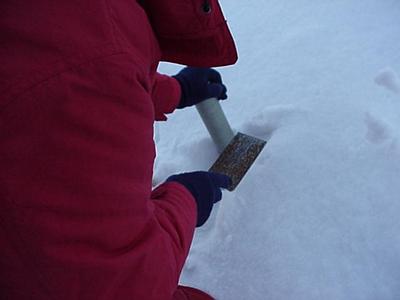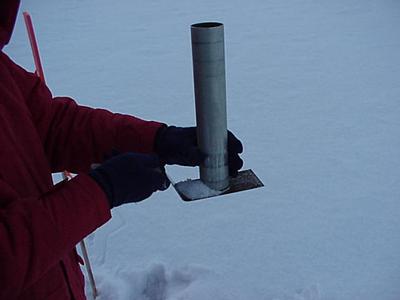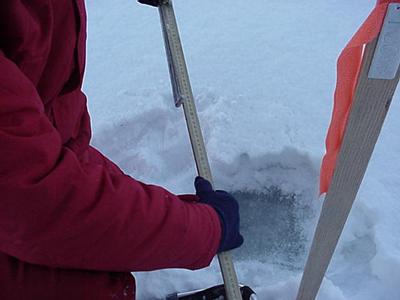16 November, 1999
Meanwhile, Back on Campus...
Today I calculated the snow densities from yesterday's samples. I also
began the task of helping Martin to organize the data that we have into
computer files. We are using "Sigma Plot", but any sets or subsets of these
data can be manipulated with "Excel", or even with a TI graphing
calculator, depending upon what you want to do! Today I'll remind you of
the types of data that we have and how we collected them. Remember,
kids...we're using metric units! Also, a transect is typically 100m long!
1. snow surface temperature (taken at both ends of the transect): Obviously
colder than the temperatures below the snow surface because it's exposed to
the air. A typical value for Monday was -12C. The mean snow surface
temperatures will be important when we calculate heat fluxes!
2. snow depth (taken at every meter along the transect): If you have ever
heard of a "blanket" of snow, then you will know that the snow serves as a
good insulator, and will reduce heat transfer. Our handy-dandy temperature
probe also serves as a measuring device, but you could just use a meter
stick. A typical snow depth from Monday was 10cm. (We will not use meters
because the equations that we will be using to calculate flux require that
we use centimeters.)
3. snow/ice interface temperature (taken at every meter along the
transect): Keep in mind that lake water freezes at 0C and that the surface
of the ice is "blanketed" with snow. It shouldn't surprise you, then, that
these temperatures will be warmer (i.e. closer to 0C) than were the
temperatures on the snow surface! A typical value from Monday was -4C.
4. snow density (taken at every 10 meter interval): Skiing fans like the
fluffy stuff, and snow-fort fans like the wet stuff! Basically, everyone
who knows snow knows something about snow density! Snow that is less dense
has more air between the snow crystals, and will be a better insulator.
Snow that is more dense will not insulate as well. Another way of picturing
this is to compare a wet ski coat (with fewer air pockets) to a dry &
fluffy ski coat (with lots of air pockets). Which will keep you warmer? In
order to calculate density you will need to collect a known volume of snow.
You should place it into a leak-proof container so that the mass in grams
can be determined back in the lab (see photo). Remember, density =
mass/volume (units are g/cc). You can see from the photos below that we
collected the snow in a cylinder. Since we know the radius of the cylinder
and the "height" of the snow, our volume would be: (pi)x(radius
squared)x(snow depth) Remember to use cm!
5. ice thickness (taken at every 10 meter interval): The thickness of the
ice is crucial for our calculation of heat flux. This step will require the
most work, but will keep you warm! You will need some sort of drill or ice
auger, and a rod shaped like a tall "L". The rod can be lowered into the
drill hole until the bottom of the L catches the lower ice surface. By
pinching your fingers on the part of the rod that is at the upper ice
surface, you'll be able to determine the ice thickness. (see photo) A
typical ice thickness from Monday's field work was 29 cm. This was about
5cm thicker than it was two weeks ago!

-17 Celsius and a bit of frost in the hair!

The simple tools needed to collect a known volume of snow

Taking the snow sample

TA-DA!! We have successfully snatched our sample!

Reaching to the underside of the ice

Measuring the ice thickness
Contact the TEA in the field at
.
If you cannot connect through your browser, copy the
TEA's e-mail address in the "To:" line of
your favorite e-mail package.
|
